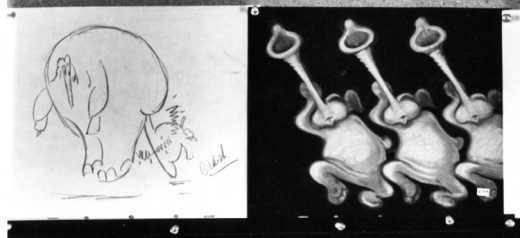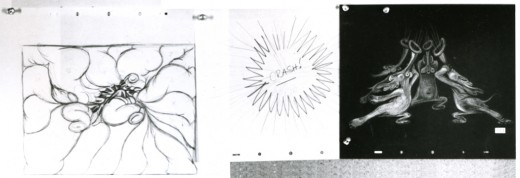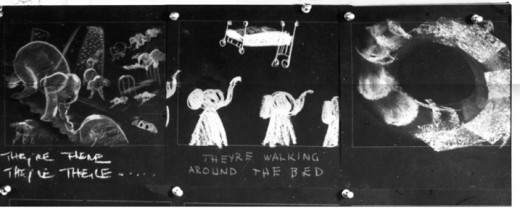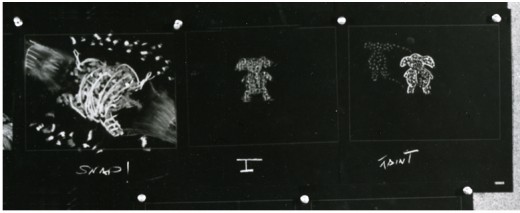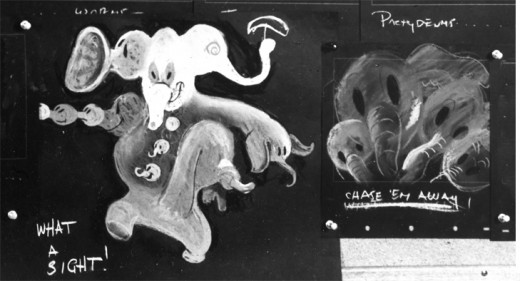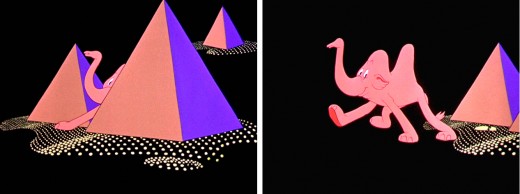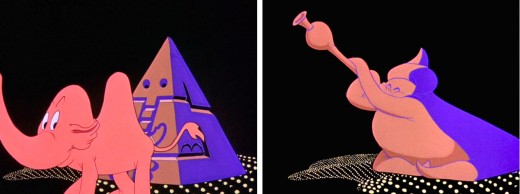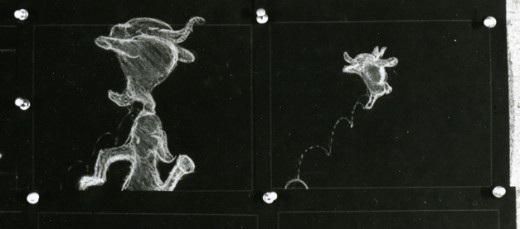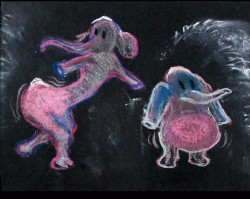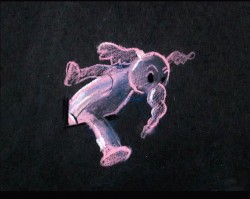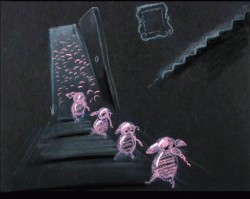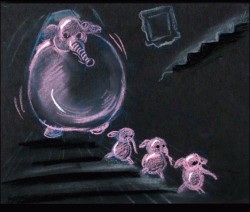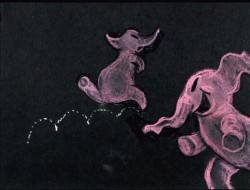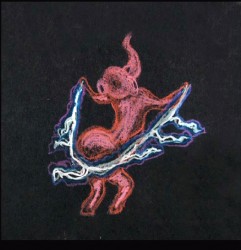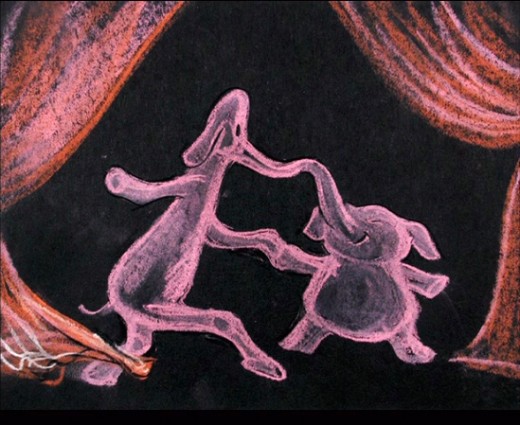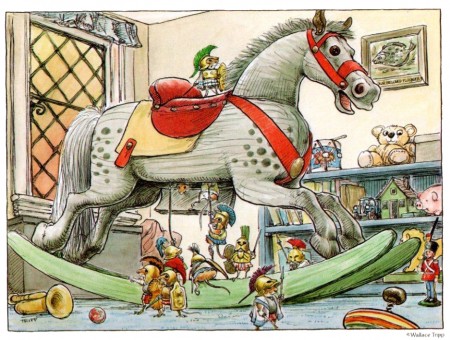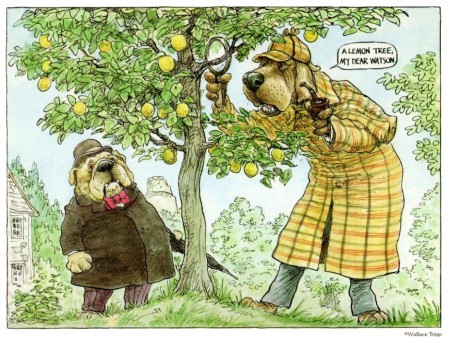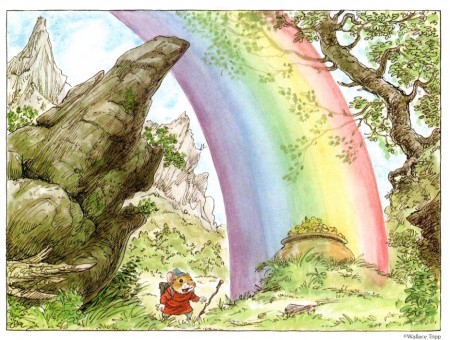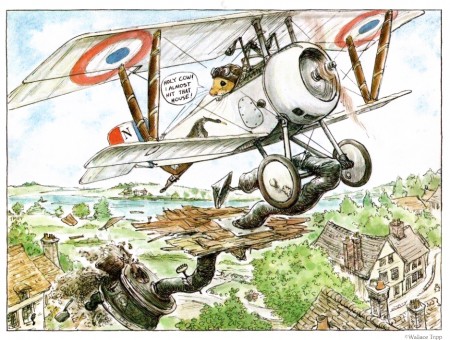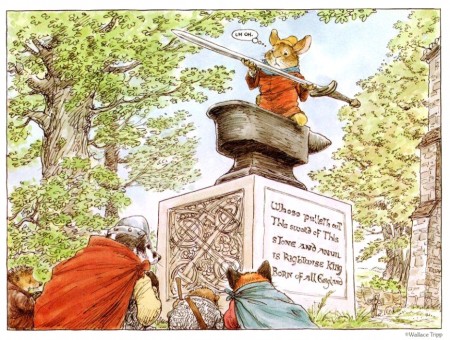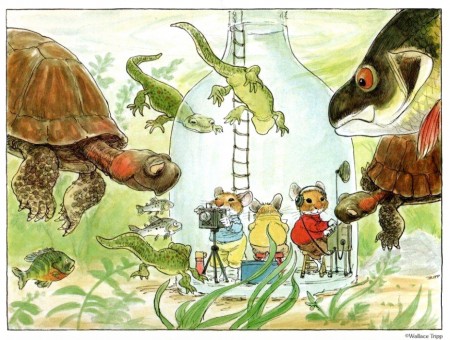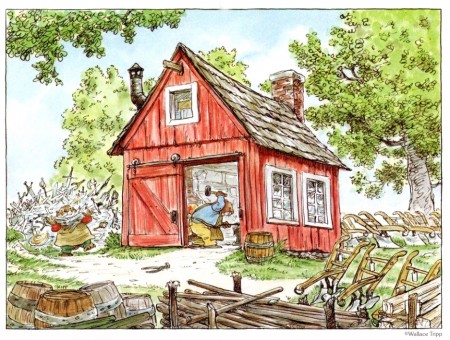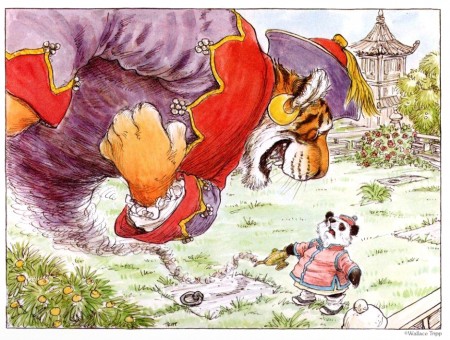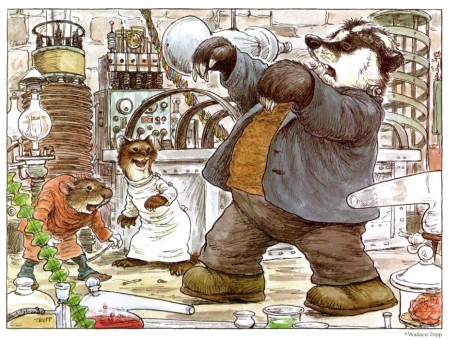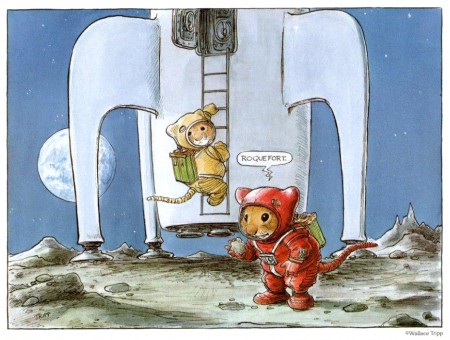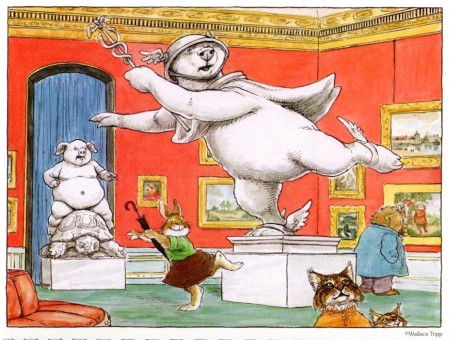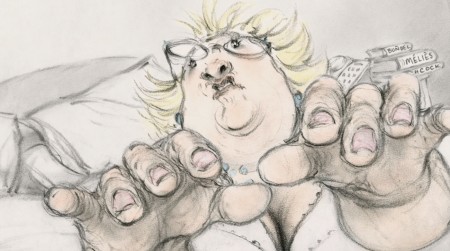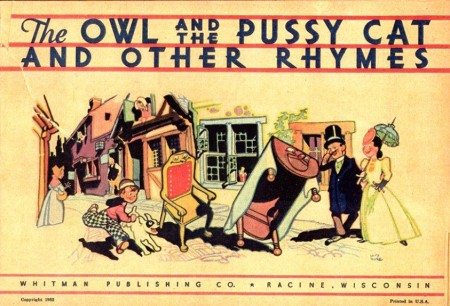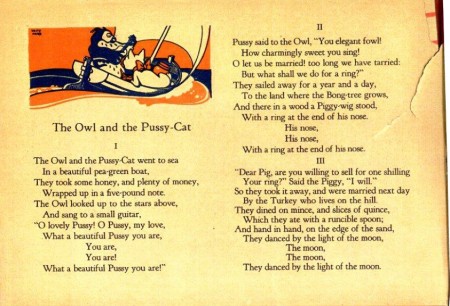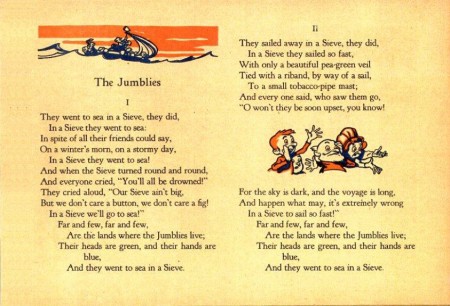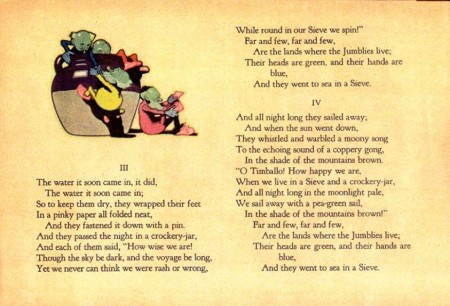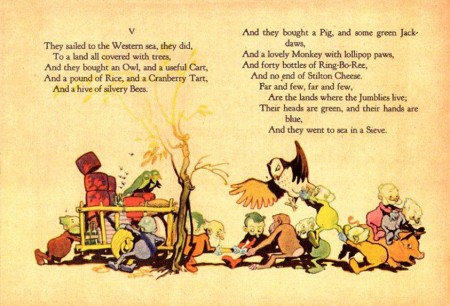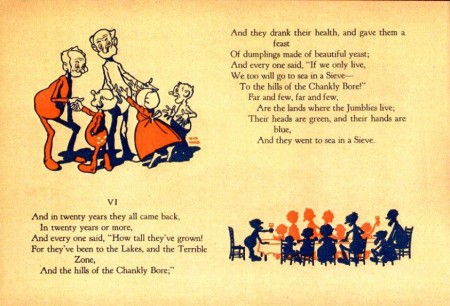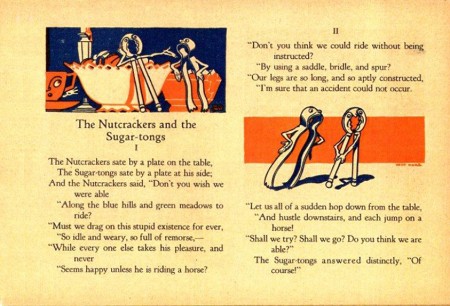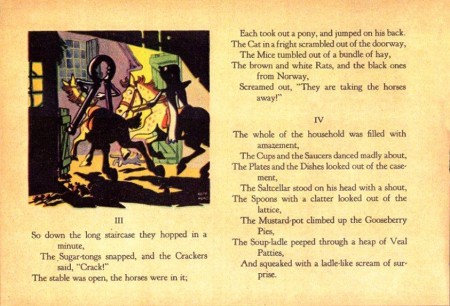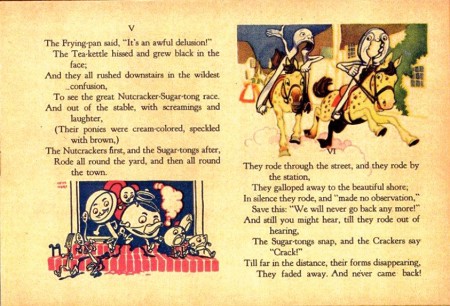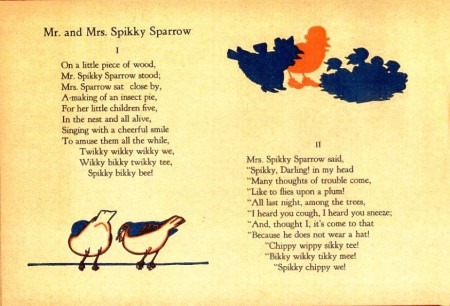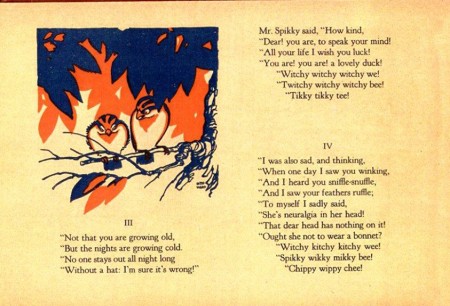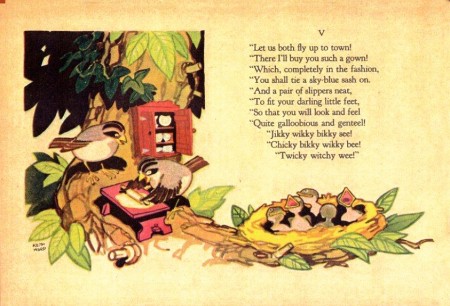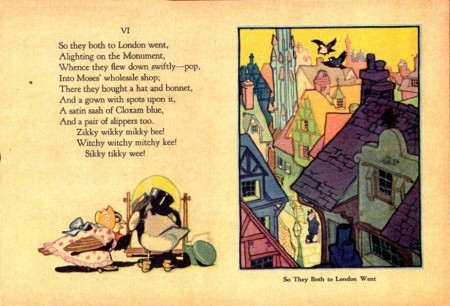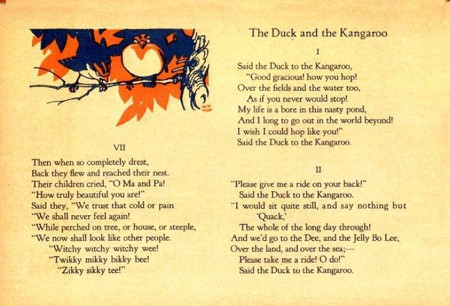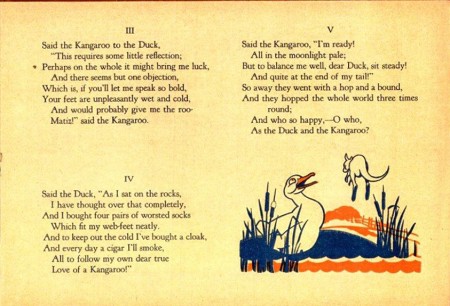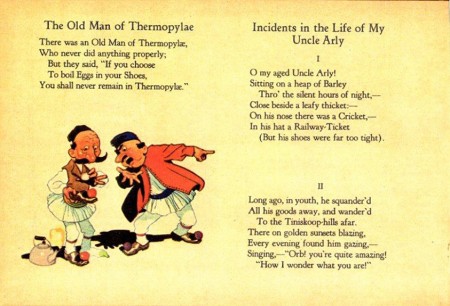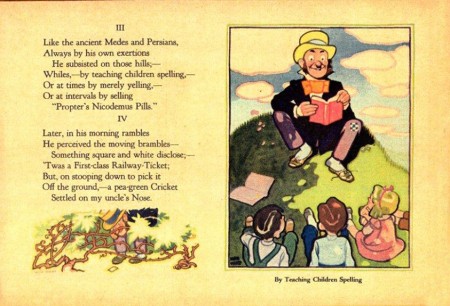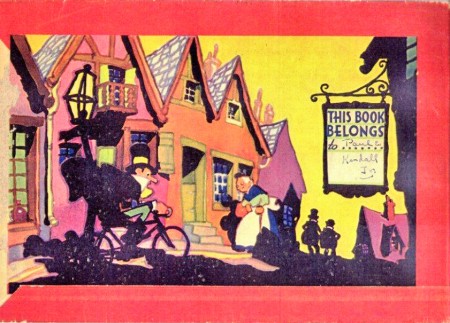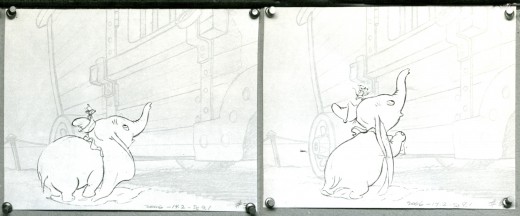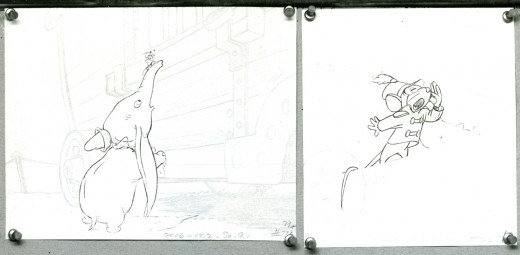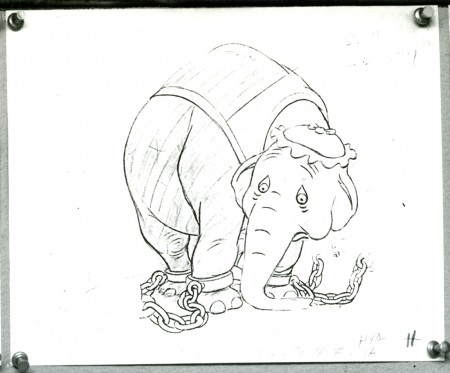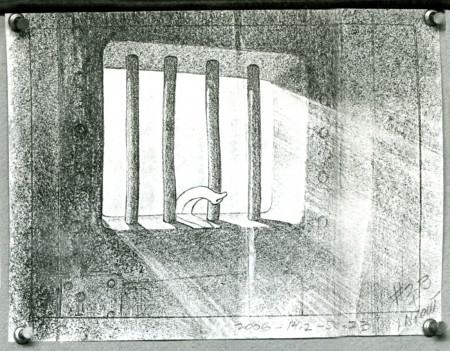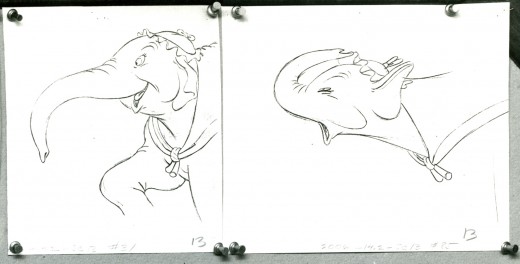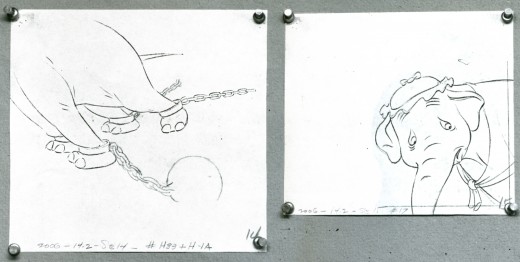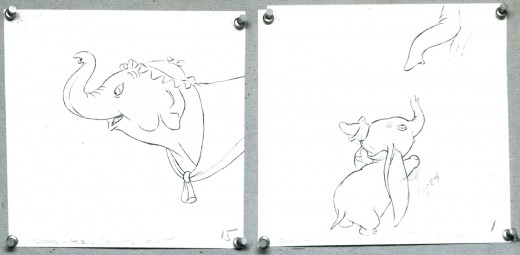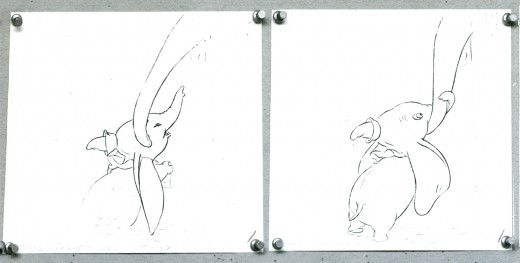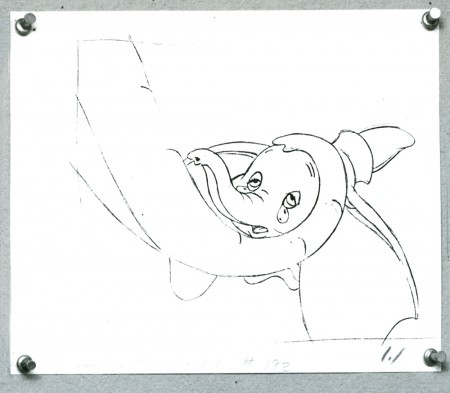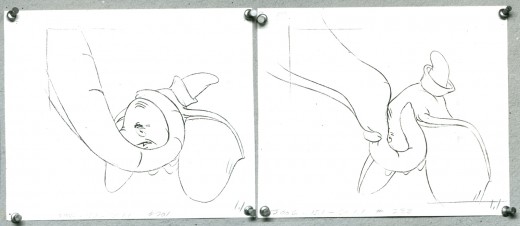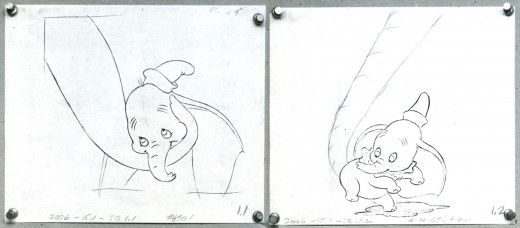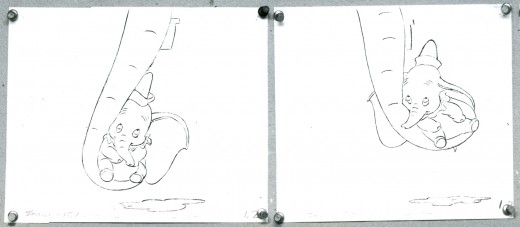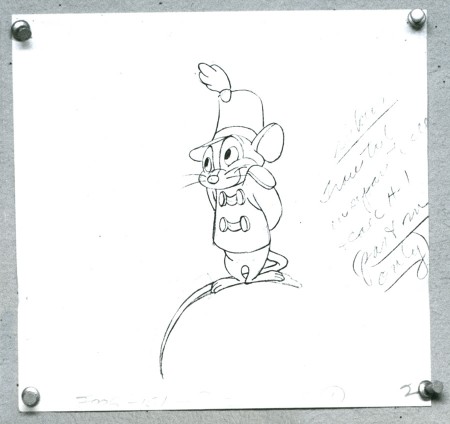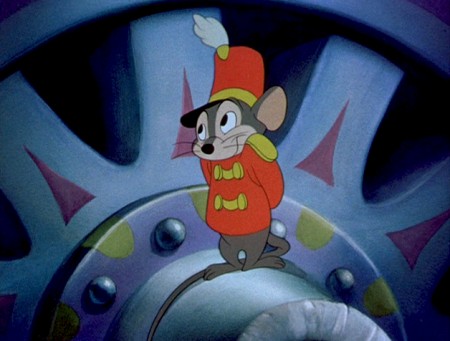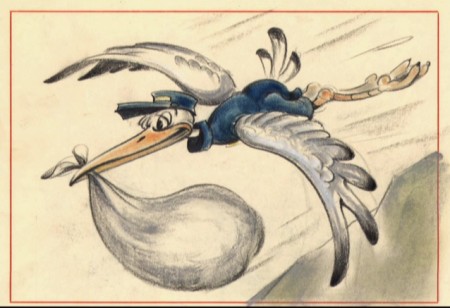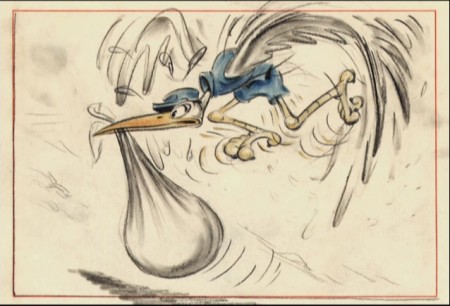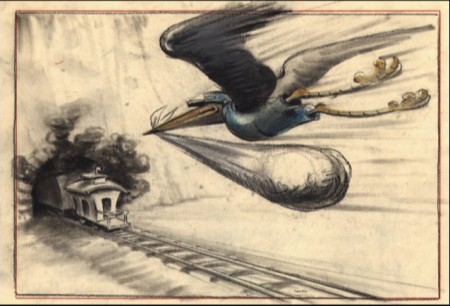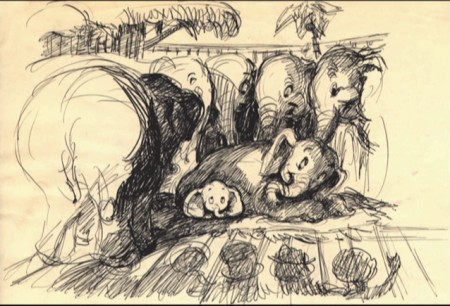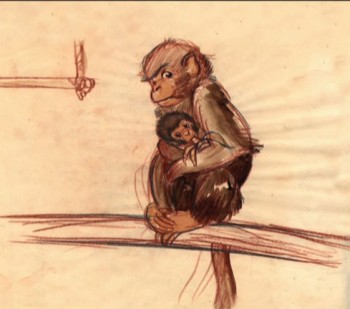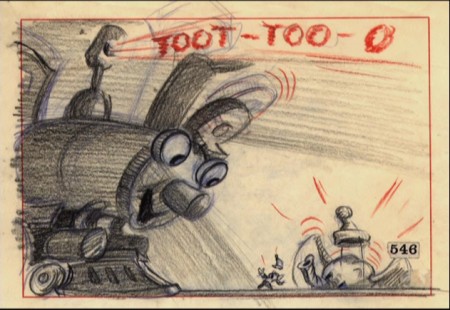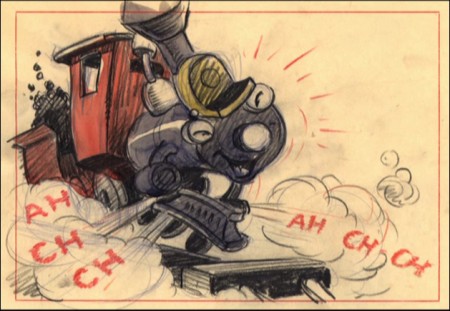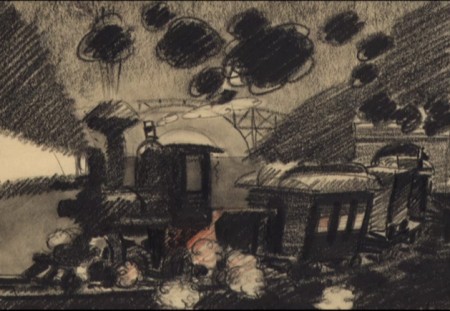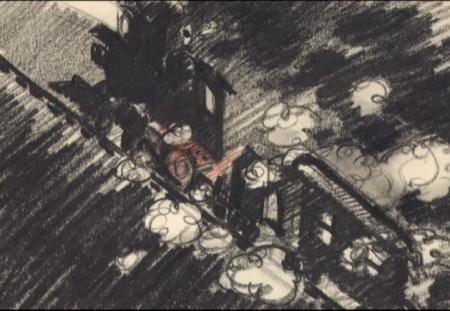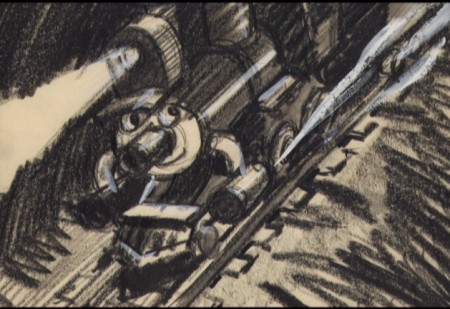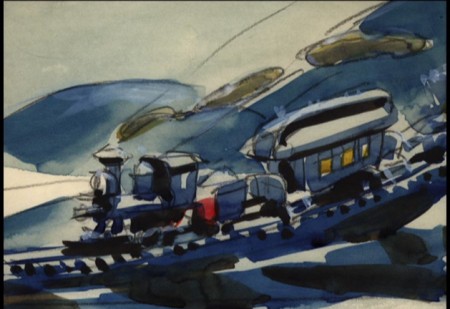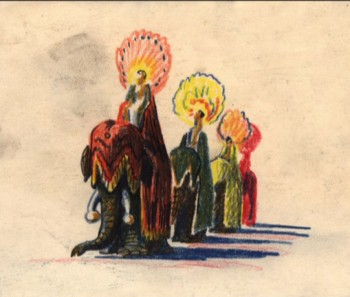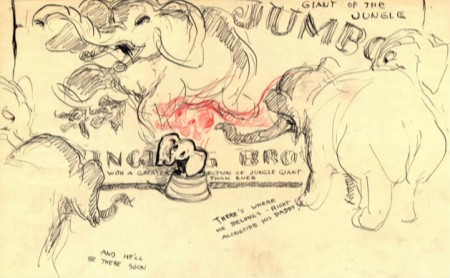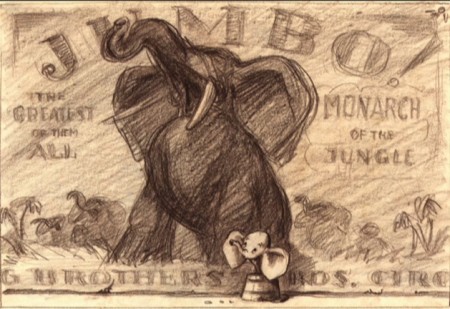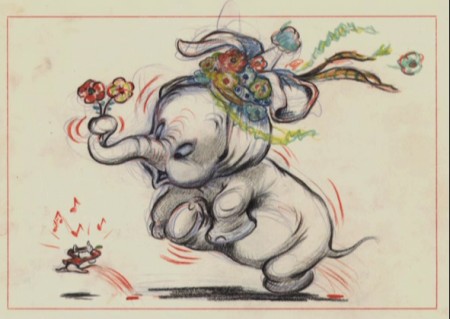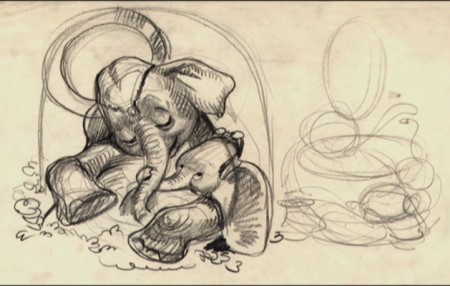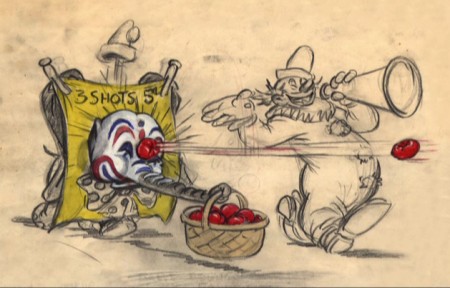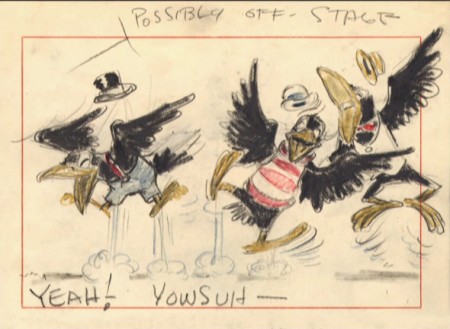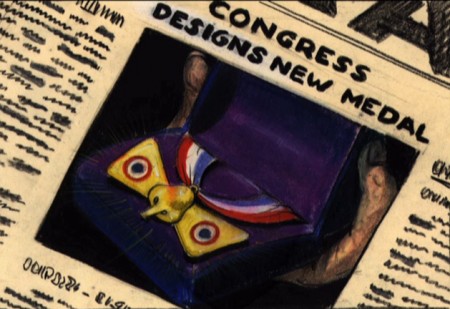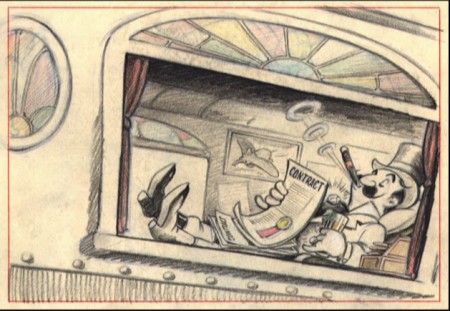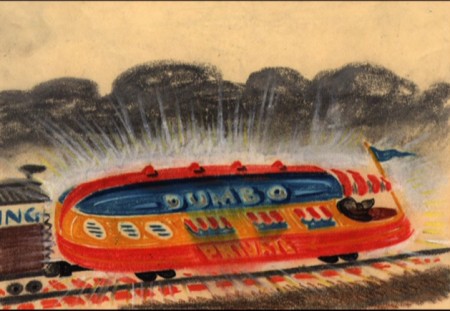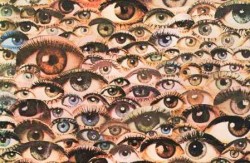Monthly ArchiveMay 2010
Animation &Disney &Story & Storyboards 31 May 2010 08:26 am
Pink Elephants
Hans Perk has posted the drafts for Dumbo, and this has led Mark Mayerson to post the brilliant Mosaics he creates for the film.
Here’s a recap of a post I did some time ago, to keep in the spirit of Dumbo. The Pink Elephant sequence.
.
- Once again, thanks to John Canemaker, I have several photo images to display. Some frame grabs accompany the piece.
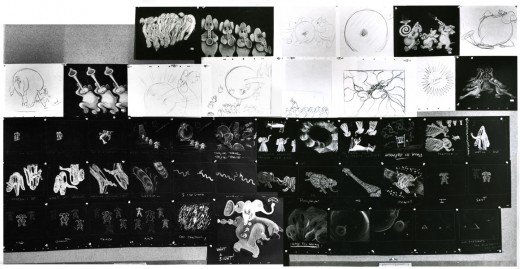
These are rather small images, so by cutting up the large boards and reassembling them I can post them at a higher resolution, making them better seen when clicking each image. It’ll take two days to post them all, so this will be continued later this week.
I’ve interspersed some frame grabs fromt the sequence to give an idea of the coloring.
The following images were in the gallery part of the dvd. These are the color versions of some of the images above.
From Hans Perk’s A Film LA:
Seq. director Norm Ferguson, asst. dir. Larry Lansburgh, layout Ken O’Connor.
Howard Swift and Hicks Lokey animated it.
Art Art &Commentary 30 May 2010 09:19 am
The Best Years
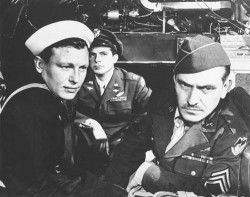 - The magnificence of William Wyler‘s film, The Best Years of Our Lives, cannot be overstated. To me, it’s a near-perfect movie. The direction, the script, the cast, the cinematography and the music all done by masters at their peaks blends into an extraordinary film.
- The magnificence of William Wyler‘s film, The Best Years of Our Lives, cannot be overstated. To me, it’s a near-perfect movie. The direction, the script, the cast, the cinematography and the music all done by masters at their peaks blends into an extraordinary film.
When I was 11, this film was about to start on The Late Show, a local CBS late night movie that began at 11:15pm. My father asked me if I wanted to stay up to watch it. He said it was one of the all-time greats. Now, I have to admit I didn’t always agree with what he felt were the all-time greats, but I stayed. Within ten minutes, I was in tears as the three military men return to Boone City, their small home town. The cab drives by the many small stores and houses in the area, and little more than the sight of these passing buildings wells the tears in your eyes as you feel what these three guys are feeling. That Wyler would have accomplished so much emotion in so short a time is extraordinary.
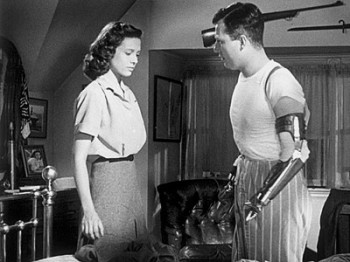 I stayed with the 2½ hr. film, even though my father fell asleep hours before the end. He was right, it was an all-time great. I’ve since seen the film at least 50 more times. In the past two months, I’ve spent a lot of time at home, recovering from an operation, and have seen many, many movies over that time. Last night, TCM aired it again (the second time in the last two weeks) for Memorial Day. I was pulled into it again, and I’m happy for it.
I stayed with the 2½ hr. film, even though my father fell asleep hours before the end. He was right, it was an all-time great. I’ve since seen the film at least 50 more times. In the past two months, I’ve spent a lot of time at home, recovering from an operation, and have seen many, many movies over that time. Last night, TCM aired it again (the second time in the last two weeks) for Memorial Day. I was pulled into it again, and I’m happy for it.
Wyler, it seems, had absolute patience for long self-explaining scenes. He gave characters plenty of time to pause and think, and their thoughts register fully and loudly to us. It’s amazing business that today’s films (and probably their audience) cannot sit still to watch. With this film, you can see how much you’re missing in that impatience.
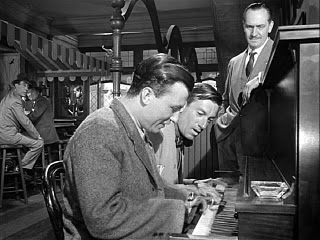 The photography by the great Gregg Toland has to be second only to his work on Citizen Kane. The deep focus imagery is used to pull strong emotion and tell the story more simply. As Homer (Harold Russell) and Butch (Hoagy Carmichael) play chopsticks in the foreground, we’re watching Fred (Dana Andrews) make a desperate and sad phone call far in the distance of the bar. While Homer and Wilma marry to the right of the screen, Fred, in the foreground, is watching Peggy (Teresa Wright) in the distance. There are those scenes of Fred walking among the detritus of the Air Force as hundreds and hundreds and hundreds of fighter planes line up for destruction.
The photography by the great Gregg Toland has to be second only to his work on Citizen Kane. The deep focus imagery is used to pull strong emotion and tell the story more simply. As Homer (Harold Russell) and Butch (Hoagy Carmichael) play chopsticks in the foreground, we’re watching Fred (Dana Andrews) make a desperate and sad phone call far in the distance of the bar. While Homer and Wilma marry to the right of the screen, Fred, in the foreground, is watching Peggy (Teresa Wright) in the distance. There are those scenes of Fred walking among the detritus of the Air Force as hundreds and hundreds and hundreds of fighter planes line up for destruction.
Hugo Friedhofer was a great arranger and song writer. His score for this film stands out as one of the great scores of all time. It carries you through the movie and strengthens the work of every other brilliant craftsman who worked on it. The music is brilliant.
I can’t say enough about this film. It’s Memorial Day, and writing about it gives me a chance to mention the holiday. But I’m certainly honoring what I feel is one of the great films of my life. I hope all of you have, at least, seen it once. If not I urge that you do. I doubt you’ll ever see the likes of it made today.

Photo by Steve Fisher
Remember the troops for Memorial Day.
Bill Peckmann &Illustration 29 May 2010 08:25 am
Wallace Tripp
- Wallace Tripp is one of those illustrators whose work seemed ready for animation. Everything he drew seemed designed and ready for animators to pick up their pencils. His illustrations for Amelia Bedilia are certainly part of the great success of that book series.
Bill Peckmann has saved this calendar from 1980 and sent it to me. It’s a great example of the work of Tripp, and I don’t mind sharing it. Great drawings, beautiful watercolors. Near perfect illustrations.
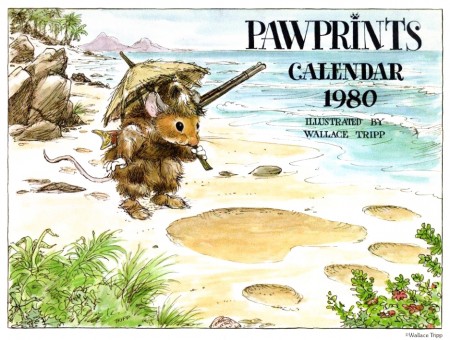 1
1(Click any image to enlarge.)
A note of thanks, yet again, to Bill Peckmann for sharing and reminding me of Wallace Tripp’s great work.
Books &Independent Animation 28 May 2010 08:10 am
More Zagreb
- Last week I posted a short bit from the excellent book by Ronald Holloway, Z is for Zagreb. We saw the bio of one of the principal leaders of this studio/school. I wanted to jump a couple of years and give the bios of two others in Zagreb whose work I particularly like. One, Zlatko Grgic, did one of my favorite Zagreb shorts, Tup Tup.
I precede those bios with another short piece from Holloway’s book.
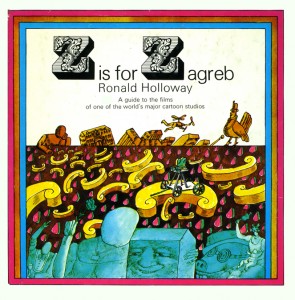 Was it really a “school”? Or a group of people who liked working together? Perhaps there’s no distinction, but the Zagreb cartoonists are proud of their individuality and even today work as free agents. Most of their films bear an individual mark, and despite tempting offers from abroad they prefer the climate of a free atmosphere to exchange ideas and seek help when they need it. The Zagreb studio is not a “school” but a “family.” No other loose climate of friendship and trust exists in animation—and the Zagreb artists had to fight to keep it that way.
Was it really a “school”? Or a group of people who liked working together? Perhaps there’s no distinction, but the Zagreb cartoonists are proud of their individuality and even today work as free agents. Most of their films bear an individual mark, and despite tempting offers from abroad they prefer the climate of a free atmosphere to exchange ideas and seek help when they need it. The Zagreb studio is not a “school” but a “family.” No other loose climate of friendship and trust exists in animation—and the Zagreb artists had to fight to keep it that way.
Soon after the balmy days of the Cannes Festival and an awakening among their own critics to the importance of their work, the management of Zagreb Film changed and instead of increased support they were greeted with open envy and distrust. Suppose the animation department became strong enough to take over the entire company? As preposterous as that sounds, it makes sense in light of the fact that animation was the first international breakthrough for the Yugoslav fiirn industry. The cartoonists were celebrated in every national newspaper. And so to forestall any possible insurrection, the management brought in “artistic directors” to keep a tight rein on the real artists in the studio.
A further argument could be made for the “artistic director” by pointing out the directorial posts of non-designers Mimica and Kostelac. Mimica was to distinguish himself in the future through Marks, and Kostelac was to do the same through Kostanjsek. Who were actually responsible for these films: the director or the designer, or possibly the team together? And in the Vukotic-Kolar team it was even more difficult to decide, because they both were designers. In any case, the management overlooked the fact that each of these individuals gave as much as they took, and decided that all an “artistic director” had to do was find an idea and pull the work out of a designer. Animation was as simple as that.
It was an unfortunate phase, and one that even today appears confused and knotty. Vukotic and Mimica remained essentially unaffected and both worked in complete harmony with the units under them. Two other directors, Dragutin Vunak and Ivo Vrbanic, were not exactly new to the ranks and for the most part were successful in forming new units. The Neugebauer Brothers had left for Germany, and some new blood was needed to replace them. The designers were not confident to start out on their own, and didn’t always mind if someone else took all the risks. The trouble arose when two young graduates of the theatrical academy. Mladen Feman and Bohslav Mrksic, were brought in by the management to run their own show without any previous experience at ail. It is worthwhile to compare the careers of Vunak, Vrbanic, Feman and Mrksic.
Vunak came from Interpublic and fitted in well with Zagreb Film’s advertising department. He had previously worked with Dovnikovic and they collaborated on the picture-book A Small Train. Later he brought in an artist friend, Aleksandar Srnec. to help create the experiment film The Man and His Shadow. He gave young Ante Zaninovic his first start with Cow on ihe Frontier, appearing at a crucial time in Zagreb’s history and saving the studio from total eclipse. He fitted a superb idea to the offbeat talents of painter-sculptor Zvonimir Loncaric and made the credible Between Lips and Glass. In between he made a few bad films. The interesting factor is that each of Vunak’s successful films is in a completely different style, which leads to the conclusion that Vunak is only as good as his designer. But he nearly always picked the right designer lor the right idea, and they got along well together. Th^films could not have been completed without him.
Ivo Vrbanic is not quite in the same category. He made too many films too quickly, and most of them turned out badly. His name first appears as a co-writer of Vukotic’s satire on the horror film, The Great Fear, and he surprisingly enough has the same credit on Mimica’s Alone. He formed a brief partnership with Dovnikovic on Romeo and Juliet, and then seemed to hit the right combination with painter-designer ivo Kaiina on children’s films; A Ballad. All the Drawings of the Town, and Dance on the Hoof. He was the perfect answer for the departing Neugebauers, but he was never able to reach the heights of A Ballad and All the Drawings of the Town again. The team of Vrbanic-Grgic—Adam and Eve, Love and Film, The White Mouse, and The Rivals—shows a general discomfort with satire, although there are many nice touches throughout. The biggest mistake of Vrbanic’s career was coming into contact with the volcanic Vlado Kristl. They are billed as co-directors of La Peau de Crfagrin. but Vrbanic has very little to do with the cartoon as a whole and they were in constant disagreement from beginning to end. Vrbamfi as an artist always seems to be out of his depth in the adult cartoon but he probably would have been successful in the old Duga days.
Mladen Feman was also assigned to satire—and was the first to run headlong into the temper of Kristl. Kristl, one of the country’s leading abstract artists, had just returned from a trip through Europe and South America, and was not about to be suppressed by young graduates from the theatrical academy. They battled throughout The Great Jewel Robbery, a follow-up parody on Vukotic’s successful Concerto for Sub-Machine Gun that turned out to be better artistically and commercially than the first one. He next tried to supervise the formidable Marks in a follow-up to Vukotic’s Cowboy Jimmie, and again it was clear who was really in control of the film. He made one last attempt to prove his own worth on the doomed Inspector Mask series by directing, designing and animating independently, then left the feature cartoon for good. It can be argued in his favour that Feman never really had a chance to prove his worth under the prevailing system.
The worst case of artistic suicide was the strange career of Borislav Mrksic. He was matched with veteran designer Ismet Voljevica on the ill-fated The Kite, which is in the running for the ugliest film ever made and should be shown at the Annual Congress of Artistic Directors. After this disaster Mrksic disappeared from the studio, and Feman and Vrbanic were eventually to follow him.
Toward the end of the Fifties articles began to appear in the newspaper condemning the policy of suppressing the studio’s leading talent. Fadil Hadzic led the crusade, and he even went so far as to include Vukotic and Mimica among the guilty parties. All the credit for animation should go to the designer, he contended—an equally fallacious argument- But after a while the management went through another change and the integrity of the artists was restored. An axiom was adopted at the studio: an animated film is an author’s film. The ideal situation was for an author to be responsible for everything, from first conception through design and animation. Direction and animation need not necessarily be separated. It is an axiom that has lasted until today.
Only it’s too bad it had to cost the talents of the studio’s best artist.
Zlatko Grgic
(Born 1931 in Zagreb).
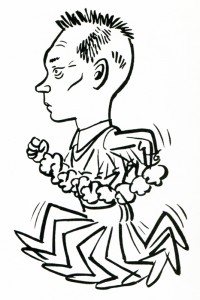 Studied journalism and law before turning to cartoons in 1951. He contributed some cartoons to Kerempuh and assisted as animator on Kostelac’s Opening Night (1957) and Encounter in a Dream (1957). He was the chief animator on Norbert Neugebauer’s The False Canary (1958), and Vukotic’s The Great Fear (1958) and Revenger (1958). He was Vukotic’s designer and animator for Cow on the Moon (1959), and later directed under Vukotic’s supervision A Visit from Space (1964) and The Devil’s Work (1965). He formed a team with Vrbanic in 1 960 and designed and animated for him Adam and Eve (1960). Love and Film (1961), and The White Mouse (1961), and animated his Rivals (1962). He was the animator on Vrbanic-Kristl’s La Peau de Chagrin (1960). He began as an independent director on an advertising film in 1960. designed and animated Branko Ranitovic’s children’s film Nisu Znaii jer su Mali (1960) for Zora Film, and directed in the Case (1961) and Inspector Mask (1962) series. Forming a team with Stalter they co-directed The Fifth (1964) and Scabies (1969). Staiter was Grgic’s background painter on The Musical Pig (1965) and Grgic was Stalter’s animator on Boxes (1967). Grgic also helped Dovnikovic on his script for Krek (1967), after Dovnikovic assisted him on the script for The Musical Pig.
Studied journalism and law before turning to cartoons in 1951. He contributed some cartoons to Kerempuh and assisted as animator on Kostelac’s Opening Night (1957) and Encounter in a Dream (1957). He was the chief animator on Norbert Neugebauer’s The False Canary (1958), and Vukotic’s The Great Fear (1958) and Revenger (1958). He was Vukotic’s designer and animator for Cow on the Moon (1959), and later directed under Vukotic’s supervision A Visit from Space (1964) and The Devil’s Work (1965). He formed a team with Vrbanic in 1 960 and designed and animated for him Adam and Eve (1960). Love and Film (1961), and The White Mouse (1961), and animated his Rivals (1962). He was the animator on Vrbanic-Kristl’s La Peau de Chagrin (1960). He began as an independent director on an advertising film in 1960. designed and animated Branko Ranitovic’s children’s film Nisu Znaii jer su Mali (1960) for Zora Film, and directed in the Case (1961) and Inspector Mask (1962) series. Forming a team with Stalter they co-directed The Fifth (1964) and Scabies (1969). Staiter was Grgic’s background painter on The Musical Pig (1965) and Grgic was Stalter’s animator on Boxes (1967). Grgic also helped Dovnikovic on his script for Krek (1967), after Dovnikovic assisted him on the script for The Musical Pig.
 After The Musical Pig Grgic has directed independently Little and Big (1966), Inventor of Shoes (1967). and Twiddle-Twaddle (1968), and co-directed with Branko Ranitovic Tolerance (1967) and The Suitcase (1969) (for Viba Film). Inventor of Shoes prompted the Professor Balthasar series (1969), the studio’s first successful adventure into a series and the combined work of Grgic. Kolar and Zaninovic. His mini mini creation is Maxi Cat. A master of free, dynamic animation with numerous twists, witty gags and unexpected turns. Grgic is one of the subtlest poets in the animation business.
After The Musical Pig Grgic has directed independently Little and Big (1966), Inventor of Shoes (1967). and Twiddle-Twaddle (1968), and co-directed with Branko Ranitovic Tolerance (1967) and The Suitcase (1969) (for Viba Film). Inventor of Shoes prompted the Professor Balthasar series (1969), the studio’s first successful adventure into a series and the combined work of Grgic. Kolar and Zaninovic. His mini mini creation is Maxi Cat. A master of free, dynamic animation with numerous twists, witty gags and unexpected turns. Grgic is one of the subtlest poets in the animation business.
Nedeljko Dragic
(Born 1936 in Paklenica).
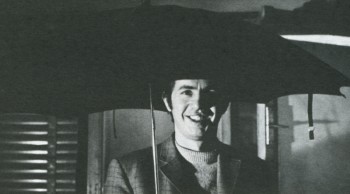 Studied law in Zagreb and worked from 1953 for a number of newspapers and journals as cartoonist. He published in 1964 a book of his cartoons, Alphabet for Illiterates, and has won awards for his “anti-” comic strips. His first contribution to the Zagreb studio was as designer for Ranitovic’s The Dreamer (1961), Kostelac’s Cupid (1961), and Vrbanic’s Rivals (1962). He designed and animated in the Inspector Mask series (1962), and returned to the studio again in 1 964 to design Pejakovic’s Once upon a Time There Was a Dot. His first independent cartoon was Elegy (1965), taken out of a page of his cartoon book, and from a Mimica script he created
Studied law in Zagreb and worked from 1953 for a number of newspapers and journals as cartoonist. He published in 1964 a book of his cartoons, Alphabet for Illiterates, and has won awards for his “anti-” comic strips. His first contribution to the Zagreb studio was as designer for Ranitovic’s The Dreamer (1961), Kostelac’s Cupid (1961), and Vrbanic’s Rivals (1962). He designed and animated in the Inspector Mask series (1962), and returned to the studio again in 1 964 to design Pejakovic’s Once upon a Time There Was a Dot. His first independent cartoon was Elegy (1965), taken out of a page of his cartoon book, and from a Mimica script he created
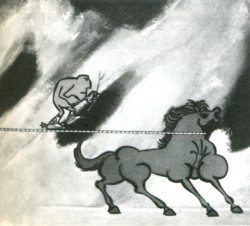 the impressive Tamer of Wild Horses (1966). But the pure Dragic is to be found in Diogenes Perhaps (1967) and Passing Days (1969), winners of numerous international awards. He scripted Blazekovic’s The Man Who Had to Sing (1970) and did the backgrounds for Dovnikovic’s The Flower Lovers (1970). He did the first mini mini films. Per Aspera ad Astra and Striptease (both in 1969), to introduce the studio’s annual production and started the creative one-minute fad. Dragi6′s satirical slams are unmatched in animation, stemming from his rich newspaper experience. He balances his sharp criticism of the world’s inhumanity with poetic touches of melancholy and nostalgia for a saner life.
the impressive Tamer of Wild Horses (1966). But the pure Dragic is to be found in Diogenes Perhaps (1967) and Passing Days (1969), winners of numerous international awards. He scripted Blazekovic’s The Man Who Had to Sing (1970) and did the backgrounds for Dovnikovic’s The Flower Lovers (1970). He did the first mini mini films. Per Aspera ad Astra and Striptease (both in 1969), to introduce the studio’s annual production and started the creative one-minute fad. Dragi6′s satirical slams are unmatched in animation, stemming from his rich newspaper experience. He balances his sharp criticism of the world’s inhumanity with poetic touches of melancholy and nostalgia for a saner life.
The unfortunate part of the book is that it was written in 1972 and doesn’t detail, as a result, the most important part of both of these artists’ careers.
Images:
1. Book cover – Z is for Zagreb
2. Zlatko Grgic
3. The Inventor of Shoes
4. Nedeljko Dragic
5. Tamer of Wild Horses
Commentary 27 May 2010 07:50 am
Joanna Quinn / Brad Bird
- I received the following press release from Joanna Quinn yesterday. Normally, I would not reprint a press release, but I think so highly of Joanna’s work and recognize that this is a truly special honor and occasion for anyone in the animation community, that I feel compelled to post it as is:
JOANNA QUINN – AWARD and EXHIBITION
Joanna Quinn one of the UK’s most celebrated filmmakers whose animated films have received many international Awards including 2 Oscar nominations, BAFTAS and Emmys, is to receive yet another major award at the 25th Cinema Jove International Film Festival in Valencia, Spain.
In June 2010 she is being honoured with the prestigious award – ‘La Luna de Valencia’ (the Moon of the City of Valencia). Previous recipients of the award have included the internationally acclaimed film directors Guillermo del Toro (Pan’s Labyrinth), Stephen Frears (The Queen, My Beautiful Launderette), Richard Lester (Superman 2 & 3, Help!), veteran cult horror master Roger Corman and
animation heroes like Alexandre Petrov, Caroline Leaf, and Piotr Dumala.
The city is simultaneously hosting a major retrospective exhibition of Joanna’s films, drawings and Artwork entitled ‘Joanna Quinn: Arte Vs. Animación’, which was originally curated and exhibited at the National Media Museum in Bradford in October 2009 under the title ‘Drawings that Move – the Art of Joanna Quinn’.
Joanna commented:
“It’s a great privilege to be receiving this award – I’m overwhelmed at the thought of being honoured in the same way as all those brilliant film directors…wow. For me it’s wonderful to see a selection of 25 years of my drawings presented in one venue. Normally people never see the individual drawings and all the work that goes into my films, so it’s great that they’ll be able to see the whole process at
the exhibitionâ€.
Exhibition information:
Joanna Quinn: Arte Vs.Animación: 13.5.2010 – 12.7.2010
Vicerectorado de Cultura, Valencia tel: (34) 607 289 990 email: sgarciar@dib.upv.es
Festival information
25th Cinema Jove International Film Festival: 19.6.2010 – 26.6.2010
Cinema Jove, Valencia tel: (34) 963 301 625 email: prensa@cinemajove.com
For further details contact: Les Mills or Catrin Unwin
44 (0)2920 666418 or 44 (0)2920 226225
email: les.beryl@fut.net or studio.beryl@btconnect.com
- Michael Barrier has returned from Russia with some entertaining pictures and travel information. He’s also been the first to comment on Thad Komorowski‘s note about Brad Bird‘s escape from animation to start directing Mission Impossible 4.
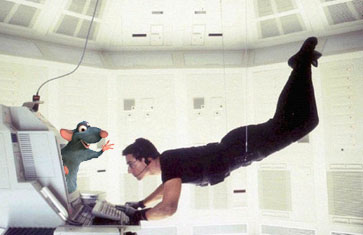 In writing his piece, Mike gets it right, I think, about changes in Pixar (post sellout to Disney) and Disney animation. It hasn’t been all good, and it looks like Bird is looking to improve his profile and financial fortunes by leaving animation behind. The same is probably true of Andrew Stanton who is now scheduled to direct a live action John Carter of Mars for Pixar. (Remember the animated tests Clampett did of this story back in the ’30s? It looked like the Fleischer Superman, years earlier.) Although in directing live action for Pixar, Stanton puts his toes in the water rather than jumping.
In writing his piece, Mike gets it right, I think, about changes in Pixar (post sellout to Disney) and Disney animation. It hasn’t been all good, and it looks like Bird is looking to improve his profile and financial fortunes by leaving animation behind. The same is probably true of Andrew Stanton who is now scheduled to direct a live action John Carter of Mars for Pixar. (Remember the animated tests Clampett did of this story back in the ’30s? It looked like the Fleischer Superman, years earlier.) Although in directing live action for Pixar, Stanton puts his toes in the water rather than jumping.
It’s questionable whether Bird will come back to animation. His fortunes, fame and pleasure will probably be greater in live action. Of course, the film will be crap (could anything called Mission Impossible 4 be anything but?) Remember that Tom Cruise plucked up J. J. Abrams from the first season of Lost to give him Mission Impossible III, thus making him an industry powerhouse in Hollywood. It’s not unlikely that the same could happen to Brad Bird.
Bill Peckmann &Books &Illustration 26 May 2010 08:43 am
Edward Lear Nonsense – 1
- I’ve been a fan of Edward Lear forever. When Bill Peckmann sent me this incredible book with these great illustrations by Keith Ward, I had to open it up to you. I hope you enjoy it. (By the way, I’ve tried to find out about Ward, but I keep coming up with a philospher in England who doesn’t fit the bill. If you know anything about him share. Bill Peckmann led me to this link.)
The book was published in 1922.
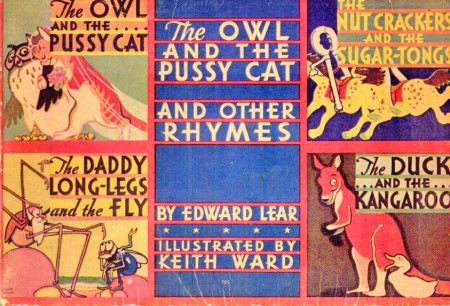
The book’s front cover.
By the way, the book is long, so it’ll come in a couple of parts.
Animation &Animation Artifacts &Disney 25 May 2010 08:05 am
Baby Mine Breakdown
Hans Perk has been posting the drafts for Dumbo, and this has led Mark Mayerson to post the brilliant Mosaics he’s creating for the film.
Here’s a recap of a sequence I wrote about for the film, the Baby Mine sequence.
.
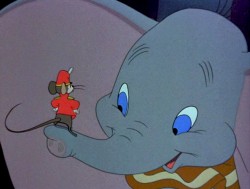 - Dumbo is certainly one of my favorite Disney features if not THE favorite. Naturally, the “Baby Mine” sequence is a highlight. The sequence is so tender and fine-tuned to appear straightforward and simple. This, of course, is the heart of excellence. It seems simple and doesn’t call attention to itself.
- Dumbo is certainly one of my favorite Disney features if not THE favorite. Naturally, the “Baby Mine” sequence is a highlight. The sequence is so tender and fine-tuned to appear straightforward and simple. This, of course, is the heart of excellence. It seems simple and doesn’t call attention to itself.
This is a storyboard composed of LO drawings from the opening of that sequence. They appear to be BG layouts with drawings of the characters cut out and pasted in place.
It’s not really a storyboard, and I’ve always wondered what purpose such boards served to the Disney machine back in the Golden Age.
Below is the board as it stands in the photograph.

_____________(Click any image to enlarge.)
Here is the same photographed board, split up so that I can post it in larger size. I’ve also interspersed frame grabs from the actual sequence for comparison.
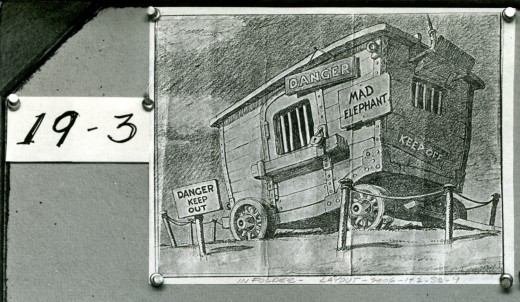
Info from Hans Perk at A Film LA:
Directed by Bill Roberts and John/Jack Elliotte, assistant director Earl Bench, layout Al Zinnen.
Animation by Bill Tytla (Dumbo & Mrs. Jumbo’s trunk), Fred Moore (Timothy) and assorted animals by Bob Youngquist, Harvey Toombs, Ed Aardal and John Sewell.
Animation Artifacts &Disney &Story & Storyboards 24 May 2010 09:00 am
Dumbo random storyboard
- Continuing with the Dumbo fest, I’ve culled a lot of storyboard drawings from various sources (many from the earliest DVD of the film) and present in somewhat chronological order.
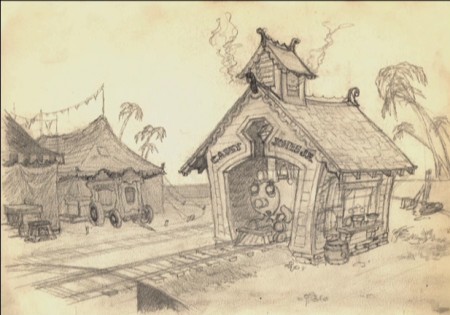 1
1
This, like my other Dumbo posts, is in support of Hans Perk‘s posting the drafts for Dumbo, and Mark Mayerson‘s posting the excellent Mosaics he creating for the film. See both other sites.
Bill Peckmann &Photos 23 May 2010 09:24 am
Birdhouses
- Bill Peckmann sent a cute piece that I thought I’d share with you. Let me put it in his words:
Your “Dumbo” posts have been outstanding, beautiful!
I thought you might enjoy these 4 Emails.A few years ago, our little town of Rhinebeck’s charity drive involved local artists taking a “Birdhouse” theme (riffing other big cities cows, horses, fish etc.) and making a statement with it. This was the 3rd one I did, with “Casey Jr.” always being in the back of my mind.(See #3 & #4)
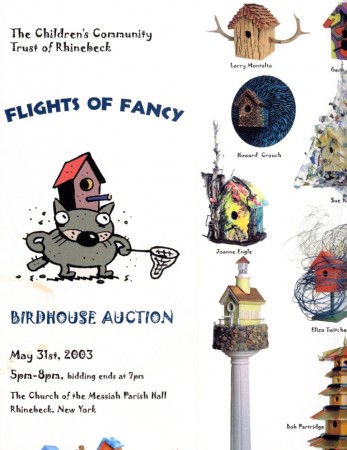 #1
#1This is apparently an invitation to create.
.
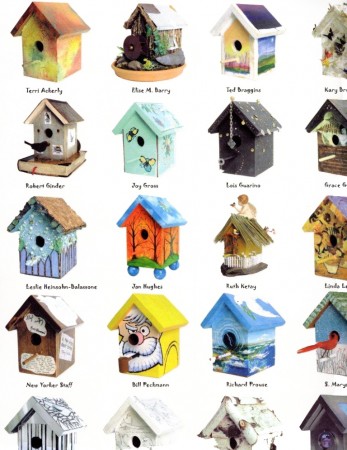 #2
#2(Click any image to enlarge.)
.
 #3
#3.
 #4
#4(Sorry, our pooch snuck in there.)
Many thanks to Bill Peckmann for sharing the photos and the creativity.
Animation &Animation Artifacts &Commentary &Independent Animation &Puppet Animation 22 May 2010 09:05 am
Bits
- I recently received this comment from Amy Bunin, the daughter of Lou Bunin, and was afraid it might have been missed. So I’m posting it here.
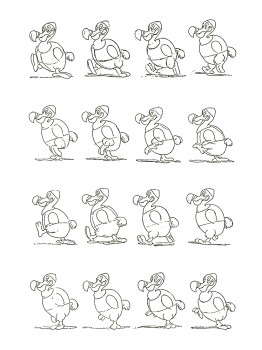 Just a note to say that my sisters and I have put our family collection of Lou Bunin’s puppets and artwork from Alice in Wonderland up for auction at Profiles in History.
Just a note to say that my sisters and I have put our family collection of Lou Bunin’s puppets and artwork from Alice in Wonderland up for auction at Profiles in History.
Lou’s stuff is on “Day 2″ of the auction. The sketches by Art Babbitt of the Dodo walking that are featured in Shamus Culhane’s Animation book (see above) –along with 10 or so other characters– are included: Lot 634. Wish us luck!
I have also started a blog on my father’s life and work – www.loubunin.com
Amy Bunin
This is an excellent blog with lots of information and stories about Lou Bunin and his work. I encourage you to go take a look.
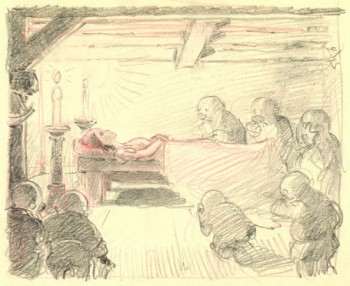 - John Canemaker ‘s most recent blog entry for Print Magazine is now posted and can be found here.
- John Canemaker ‘s most recent blog entry for Print Magazine is now posted and can be found here.
John writes a clear and full comparative study between the work of Albert Hurter, one of the principal designers of Snow White, and some of Giotto’s Renaissance painting.
He shows how Hurter may have been influenced. It’s a good read for any enthusiasts of Snow White, Hurter or Giotto.
Frank and Caroline Mouris have been making innovative, Independent animation forever. Their initial film, Frank’s Film, swept the world quickly and won the Oscar making a Frank a household name among animators in the 1970′s.
ASIFA-East is presenting an evening of their films on Tuesday, June 15. It’s sure to be an entertaining and enlightening event. Keep the date open to join the couple as they present their films.


